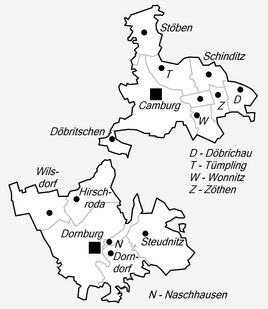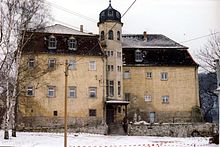Tümpling (Dornburg-Camburg)
|
Puddling
City of Dornburg-Camburg
Coordinates: 51 ° 3 ′ 50 ″ N , 11 ° 42 ′ 1 ″ E
|
|
|---|---|
| Height : | 126 m |
| Postal code : | 07774 |
| Area code : | 036421 |
|
Location of Tümpling in Dornburg-Camburg
|
|
Tümpling is a district of the city of Dornburg-Camburg in Thuringia .
geography
About 1.5 km north of Camburg, on the right bank of the Saale , at the tributary of the Schinditz brook, is the town of Tümpling. Alluvial soil is stored in the Saale floodplain . On the slopes there is shell limestone , which is covered by loess on the higher plateaus.
history
The place is indirectly mentioned for the first time in 1337 by the noble family named after the place of the von Tümpling family . The oldest forms with the ending "icz" show that it was originally a Slavic place. The castle of the same name is elevated above the Saale floodplain and the town, surrounded by a park and gardens, and was grown together with the former estate . Multiple divisions of the family meant that a second aristocratic seat was created in the village itself. We received first reports from residents of the place from the 1420s.
Tümpling belonged to the Wettin office of Camburg at the latest since the 14th century , which, due to several divisions during its existence, was under the sovereignty of various Ernestine duchies . In 1826, the place came as part of the Camburg exclave from the Duchy of Saxony-Gotha-Altenburg to the Duchy of Saxony-Meiningen . From 1922 to 1939 the place belonged to the Camburg district department .
The Tümpling manor was expropriated after the Second World War following the decision of the victorious powers . From then on, it served as the plant of an agricultural production cooperative (LPG) . In 1993 a descendant bought the property back.
Tümpling was part of the parish of St. Petersberg, north of Camburg, until the 1530s. This was a branch of Camburg during the Reformation. At the beginning of the 17th century, Tümpling was parish directly to Camburg.
lock
economy
In 1923 Eduard Vogt ran the manor with the manor Stöben. He cultivated 250 hectares. Koch was also chairman of the Thuringian horse breeding association for many years.
The farm was expropriated and divided among farmers. Today companies have settled in a small industrial area.
Web links
Individual evidence
- ^ Paul Böhme: Document book of the monastery gate. Half volume 2: 1301 to 1350 (= historical sources of the province of Saxony and adjacent areas. 33, 2, ZDB -ID 985357-1 ). Hendel, Halle 1904, 557.
- ^ Andrei Zahn: The residents of the offices of Burgau, Camburg and Dornburg: a prayer register from around 1421–1425. AMF publication series; 55; Mannheim, 1998.
- ↑ Andrei Zahn: Was there a monastery on the Cyriaksberg near Camburg / Saale? - Investigations on St. Cyriaksberg and St. Petersberg , unpublished manuscript
- ^ Jürgen Gruhle: Land Reform Black Book. 2011, accessed on May 20, 2011 (overview by federal states and locations on expropriation measures after the end of World War II as part of the land reform).
- ↑ Eberhard Walther, Rolf Kürbs: The history of horse breeding in Thuringia. Part I - From the beginning of the 20th century to the end of World War II. In: Thuringian State Agency for Agriculture. History booklet. 8 = Thuringian State Institute for Agriculture. Series of publications. Issue 13, 2002, ISSN 0944-0348 , pp. 15-52.


